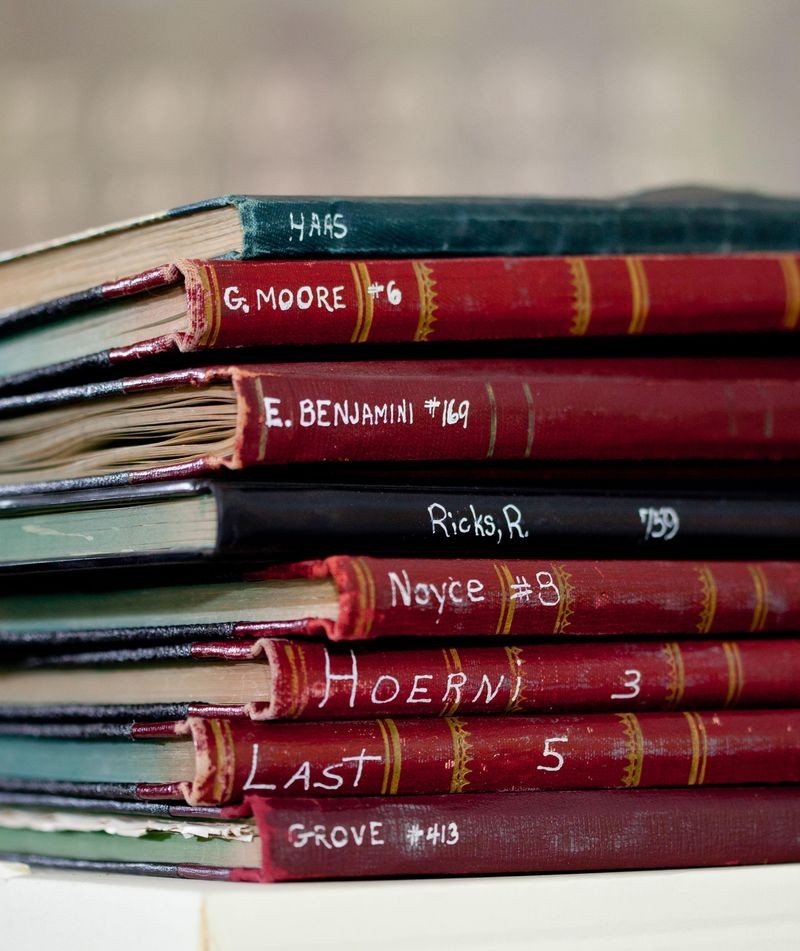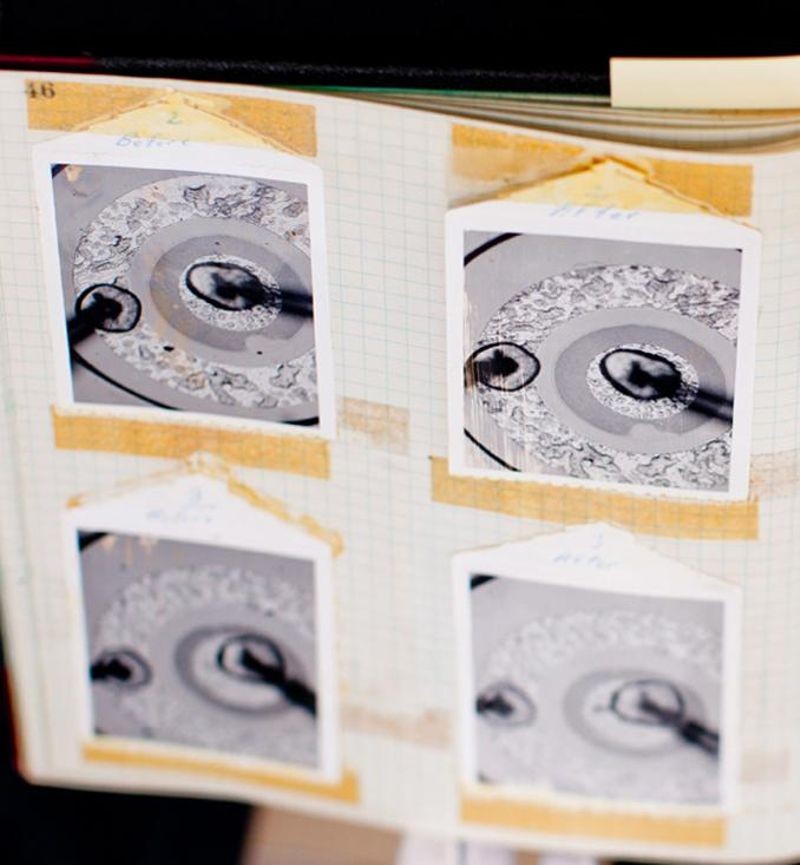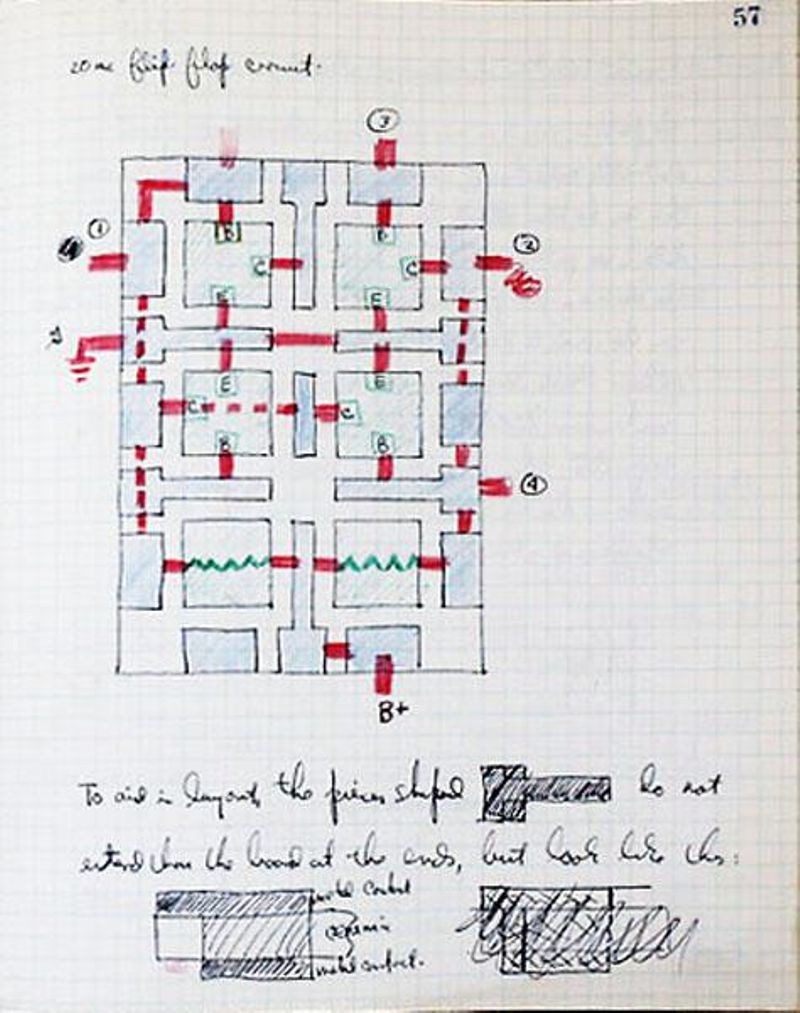

Fairchild Patent and Laboratory notebooks
In July 2012 the Computer History Museum accepted a donation from Texas Instruments Inc. of over 1,300 patent and laboratory notebooks written by Members of the Technical Staff and other employees of the Research and Development Laboratory of Fairchild Semiconductor. TI acquired the books when it purchased National Semiconductor, which had owned them since its acquisition of Fairchild Semiconductor in 1987. Included with the notebooks were two indexed collections of technical reports and technical memos written between 1959 and 1973.
Founded in 1957 by eight scientists and engineers from Shockley Semiconductor Laboratory, Fairchild Semiconductor invented new technologies, pioneered an entrepreneurial business culture, and spawned manufacturing and marketing techniques as well as numerous spin-off companies that that gave birth to the phenomenon we know today as Silicon Valley. For the next 30 years, the company’s research staff located in Palo Alto, California maintained notebooks that recorded patentable ideas and day-to-day accounts of their work.
Hand written and illustrated, each book is filled with calculations, plots, graphs, tables, photographs, and samples of silicon wafers and other mementos, and offers a unique insight into the work and life of the author. By itself every book tells a story. Collectively, they tell the history of a generation that changed the world. They have been described as the “Founding Documents of Silicon Valley”.

Transistor chip photos from Gordon Moore’s notebook
Fairchild’s history-making contribution was the development of the planar process, a manufacturing technique that improved the reliability of transistors and enabled the high-volume production of integrated circuits. This fundamental technology was then applied to the invention of the low-power CMOS circuit behind every personal electronic device today, to pioneering work in semiconductor memory, to the development of analog chips that allow humans to interface to the digital world of electronics, and to a wide range of optoelectronic and other specialized devices. All of these breakthroughs and many more, grew from ideas documented in these books.
The Museum advised that conservation and processing of the notebooks by the curatorial and archival staff would take place over the next several years. They will form the basis of future exhibitions, publications and education programs and an important resource for historians.
With the aid of a generous donation from Paul and Antje Newhagen, the first phase of this task was completed in March 2013. This comprised the restoration of five signature books written by Fairchild founders, Jean Hoerni, Jay Last, Gordon Moore, and Robert Noyce, and former CEO and Chairman of Intel Corporation, Andy Grove. It also included the creation of facsimile copies of the Hoerni, Moore and Noyce volumes, the development of a temporary exhibit and introductory video in the lobby of the Museum, and the curatorial cataloging of 200 of the most significant volumes.
Sara Lott described the restoration project in her blog “Conservation of the Fairchild Notebooks” in August 2012. My assignment was to prepare comments for a “Curatorial Enhanced Catalog Record” of the collection.

First page of Robert Noyce’s IC patent disclosure
The books are in two basic formats; Patent notebooks and Laboratory notebooks. The Patent notebooks issued from 1957 to the mid-60’s were black, cloth-bound volumes (National Figuring Book model # 56-800) measuring 10 by 12 inches with a gold-embossed red spine and corners. They held 152 numbered and quadrille-ruled pages on a quarter-inch grid. In later years the cover binding material was changed to black heat-sealed vinyl. A sheet describing how the book should be used to record patentable ideas with instructions on obtaining appropriate peer witness of the entry was pasted into the front. Laboratory notebooks (model # 53-100) measured 8 by 10 inches and held 196 grid-ruled pages bound with a marbled black and white cardboard cover. The pages were not numbered.
No two authors used their books for the same purpose. Very few used the pages predominantly for disclosures. Grove, Hoerni, and Noyce were the most consistent in this respect. Many pages were used to record experimental data and results, to-do lists, and minutes of technical and staff meetings. Some authors filled just a few pages over several years. Others filled multiple volumes. Several were blank. An interesting shift over time is the transition from handwritten entries to text generated on a personal computer that was signed and pasted into the books.

Drawing from Jay Last’s notebook
Patent books were marked with a serial number and the author’s name on the first page and inscribed in white ink on the spine. Of the 1,334 books donated the lowest number in the collection is #3, assigned to Jean Hoerni in 1957. The highest, #3191, was assigned to Jim Early in 1986. This indicates that as many as 1,800 books were not returned as required when the author resigned or they disappeared from the R & D library where they were available for reference. Many books from the 1970’s on have the year of issue appended as a prefix to the serial number. The Early volume, for example, is marked 86-3191.
Vice President of Collections & Exhibitions, Kirsten Tashev, asked me to identify the 200 most significant volumes and then to write curatorial comments for each one that would be accessible in the collection online database. In addition to the usual title, accession number, dates, etc. we decided to include brief biographical notes, and an abstract of the key contents.
My initial challenge was how to identify the “most significant” volumes. With topics from mechanical engineering and optics to physical chemistry and quantum physics spread across more than 200,000 handwritten pages, reading every page was not an option. Selecting the first 20 or so was easy. The Fairchild founders, individuals who had gone on to senior positions in the industry or academia, and inventors of seminal patents were obvious choices. In addition to consulting with historians in the field, to select the remainder I created an author ranking system based on the number of internal R & D reports written, papers published in professional journals, and patents granted.
Using Google Patent Search, I assigned points to all authors whose names were listed as inventors on U.S. patents issued to Fairchild Camera & Instrument (approximately 450 patent numbers). I then reviewed a list of 561 internal Technical Reports published by the R&D department and assigned a point to each author. I used these two lists of names to identify those who had presented at conferences or written technical papers that were published on the IEEE Xplore website. Another useful resource was a three volume bound set of “Fairchild Research Published Technical Papers” assembled by Bruce Deal in 1988 (copy in the CHM Fairchild collection). These hold over 250 reprints of papers published from 1961 to 1987.
From late November 2012 to mid-March 2013 I reviewed and wrote abstracts for 207 volumes written by 105 engineers, scientists, and technicians over the period 1957 to 1986. Having already collected the extensive patent and publications information that each author produced during their employment at Fairchild, we decided to add that data to each catalog entry. Researchers should be aware that these lists may not be complete. The results are posted in the Fairchild Notebooks section of the Museum’s online “Search the Collection”.
The content of the notebooks includes topics ranging from original disclosures on some of the most important inventions in semiconductor history to the more prosaic details of routine staff meetings, technical problems to be resolved and organizational discontent. Together they provide unique insight into the personalities and everyday workings and challenges of Silicon Valley during its formative years. I have chosen the following volumes, organized by the serial number shown in parentheses after each name, as examples to illustrate the breadth and depth of the collection.
Jean Hoerni (Notebook 3) – Physicist and cofounder. Hoerni describes various experiments together with process and design ideas that were used as the basis for his patent filings. It includes the disclosure of a “Method of protecting exposed p-n junctions at the surface of silicon transistors by oxide masking techniques”. This was his first expression of the ground-breaking planar patent that continues to be relevant today.
Jay Last (Notebook 5) – Physicist and cofounder. Last was charged by Noyce with the task of implementing the ideas disclosed in his IC patent. Several entries in this volume address the physical isolation technique Last developed to demonstrate the first proof of concept flip-flop devices in May 1960.
Gordon Moore (Notebook 6) – Physical chemist and cofounder. Moore’s notebook contains an almost day-by-day account of the challenges and issues associated with developing the company’s first transistor for IBM. He includes many pages on “tap testing” performed to identify “crud” in transistor cans that threatened the early survival of the company. The collection includes four later volumes by Moore.
Sheldon Roberts (Notebook 7) – Metallurgist and cofounder. Roberts opens with a description of his plan to establish a silicon crystal growing capability, including the features of an ingot puller designed by the author. Succeeding pages offer detailed day-by-day accounts of progress and problems encountered.
Robert Noyce (Notebook 8) – Physicist and cofounder. With disclosures from parametric amplifiers to adaptive machines, this volume illustrates the breadth of Noyce’s creative contributions during his service as Director of Research. An entry in July 1958, where he proposed interconnecting multiple punch-through diodes on a single wafer to form a function table, shows that he was pondering approaches to microcircuit integration six months before his first conception of the planar IC described in January 1959 as “Methods of isolating multiple devices”.
Isy Haas (Notebook 23) and Lionel Kattner (Notebook 107) – Electrical engineers who developed the first planar ICs. Numerous entries describe the detailed processing and testing of wafers that led to both the prototype (physical isolation) and production (electrical isolation) units.
Sam Fok (Notebook 126) – Chemical engineer. Fok filled 9 patent and 4 laboratory notebooks that detail the development of masking and photolithographic technology over the decade of the 1960s. He taped one of the first Micrologic wafers into this volume. It retains the epoxy backing material used to implement Last’s physical isolation technique.
C. T. Sah (Notebook 17) – Electrical engineer and physicist. This book is largely devoted to experimental work on tunnel diodes, a major focus of the company’s research effort in 1959-60, but also includes his invention of the Surface Potential Controlled Transistor (SPCT), Fairchild’s first foray into MOS technology.
David James (Notebook 135) – Physicist. James describes building the equipment and growing Fairchild’s first epitaxial silicon films. This yielded a significant improvement in the IC manufacturing process. He went on to become founding president of Signetics Corporation, one of the first independent producers of ICs.
R. Beeson (Notebook 146) – Electrical engineer. Beeson presented an IEEE paper on new forms of integrated logic, including Transistor Transistor Logic (TTL) for which his supervisor, David Allison, coined the popular name T-squared L. After hearing his presentation, engineers at Sylvania adopted the idea and pioneered the first commercial TTL family. Texas Instruments copied Sylvania’s approach and with the Series 54/7400 TTL dominated the market for general-purpose logic applications for the next 20 years.
David Hilbiber (Notebook 164) – Electrical engineer. Hilbiber investigated a wide range of analog device applications, including photochoppers, temperature sensors, and operational amplifiers. He describes his most lasting contribution, the concept of the band gap reference, a key element in the design of modern IC voltage regulators.
Frank Wanlass (Notebook 239) – Physicist. Wanlass worked for Sah on MOS research. His disclosure of a “Micropower Switching Element” resulted in the seminal patent for CMOS technology. It remains the most widely used IC form today. He also described an “interesting phenomena”, the tunneling effect later exploited in EPROM memories.
Andy Grove (Notebook 413) – Chemical engineer. Grove was a member of a team hired by Gordon Moore that also included Bruce Deal and Ed Snow to solve the significant stability and other challenges associated with commercializing MOS technology. In this volume he describes ideas that led to patents as well as work that generated important understanding of surface-state charge and other characteristics of the silicon to silicon oxide interface. Grove went on to lead Intel Corporation where he became one of the most admired CEOs in American business.
Maija Sklar (Notebook 425) – The first female professional engineer hired by Fairchild R & D. Sklar authored five notebooks in which she documents her work on MOS experiments that led to her being named as co-author, with Deal, Grove and Snow, of “Characteristics of the surface-state charge (QSS) of thermally oxidized silicon,” the fifth most frequently cited paper in the history of the Electrochemical Society
Herbert Kroemer (Notebook 490) – Physicist. Kroemer was one of the first researchers to include a copy of a computer printout where he highlights an error in his program listing with the comment “What a blooper!” In 2000 he was awarded the Nobel Prize in Physics “for developing semiconductor heterostructures used in high-speed and optoelectronics”.
Many other volumes will be of interest to researchers and historians. They include books authored by individuals who went on to senior positions at Intel, such as Sunlin Chou, Dov Frohman-Bentchkowsky, Ted Jenkins, Willard Kauffman, Gerry Parker, Ron Whittier, and Albert Yu. Early work in thin film and semiconductor memory technology is described in volumes by Vic Grinich, Harley Perkins, Frank Wanlass, Jack Schmidt, and Helen Bonfadini (who documented circuits designed by Robert Norman). Books by Rex Rice and William Smith cover a fascinating, but ultimately unsuccessful, experiment in embedding computer software in silicon. Ten volumes by Warner Wandry record every optical and SEM image photographed over a 6-year period with the name and project of the requesting engineer. Jim Angell, Paul Gray, John Moll, and C. T. Sah are among important contributors who later served in academia.
These examples are quoted as representative of the breadth and depth of the collection of over 1,300 Fairchild Semiconductor notebooks and technical papers that are now in the archives of the Museum. The collection offers a unique from-the-trenches view of three decades of semiconductor technology innovation within the company most responsible for the early development of Silicon Valley and the modern integrated circuit. It also represents probably the last generation of significant scientific research that will be recorded by the inventor’s hand in this manner.
Many thanks to Sara Lott, Paula Jabloner, and Alex Lux for their help in locating and organizing the huge number of books for review and entering the information into the museum database. Also to Dag Spicer, David Brock and Michael Riordan for their advice and encouragement.